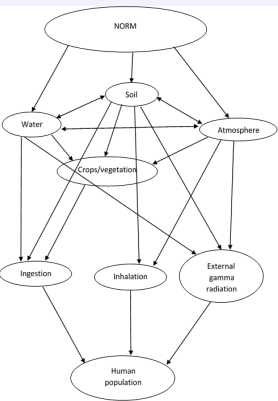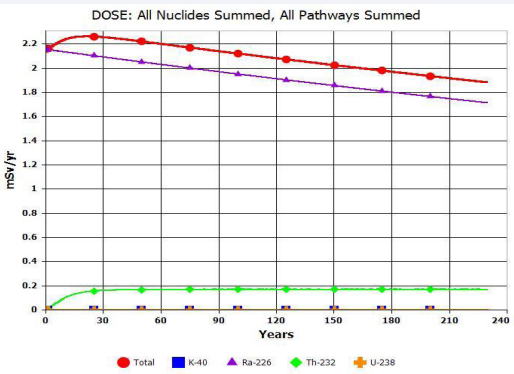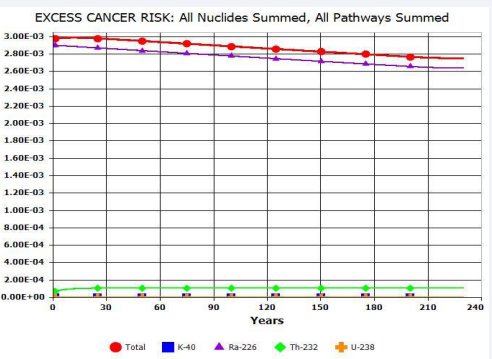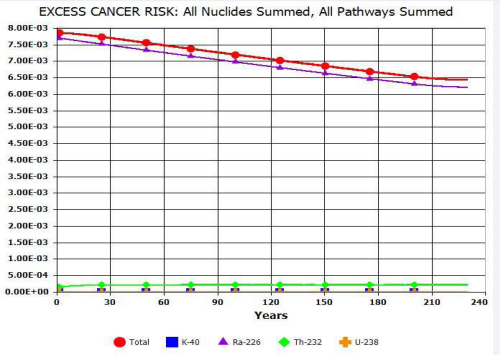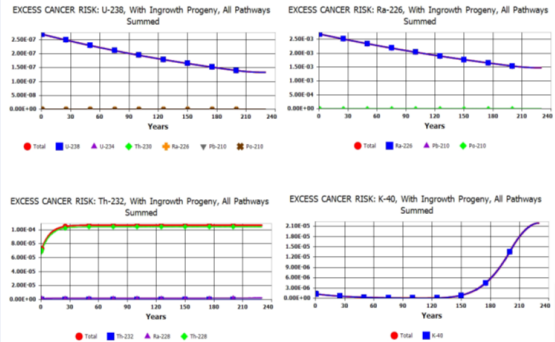Modelling Of Radiological Health Hazards in Tailing Soils from Uranium Mines in Erongo Region, Namibia
- 1. North-West University, Centre for Applied Radiation Science and Technology (CARST), South Africa
- 2. Namibia University of Science and Technology (NUST), Namibia
ABSTRACT
RESRAD-OFFSITE model 4.0 was performed with ICRP 107 based radionuclide transformations transfer factors and ICRP 60 external, inhalation and ingestion dose conversion factors. The cancer morbidity risks modelled for NORM in both mines’ samples had shown that 226Ra was the highest contributor. The RESRAD model included water, plants, soil and atmosphere exposure pathways by external gamma, inhalations and ingestions and had shown risk factors in descending order as 226Ra > 232Th > 40K > 238U. In RESRAD-OFFSITE model code, the total cancer morbidity risks in descending order were recorded as 3 persons per 1 000 populations (3 x 10-3) by tailings (stockpiles) and surrounding soil samples from mine 1 < 7 – 8 persons per 1 000 populations (7 x 10-3 – 8 x 10-3) by tailings (stockpiles) soil
samples in mine 2 < 7 – 9 persons per 1 000 populations (7 x 10-3 – 9 x 10-3) were at risks of developing cancer. This could explicitly prove that the modelled cancer risks in the region was higher than the recommended level of 1 x 10-5 factor for a population and 1x10-3 for a subpopulation documented by the World Health Organization (2011) as well as the world average (0.29 x 10-3) documented by the United Nations Scientific Committee on the Effects of Atomic Radiation.
KEYWORDS
- Human population
- Exposure
- Mining
- Radiological concentrations
- HPGe detector
- RESRAD-OFFSITE model
- Cancer morbidity risks
CITATION
Indongo V, Mathuthu1 M (2023) Modelling Of Radiological Health Hazards in Tailing Soils from Uranium Mines in Erongo Region, Namibia. J Radiol Radiat Ther 11(1): 1098.
INTRODUCTION
The continuous human exposure to radiation from the environment are a serious concern worldwide. This is due to ubiquitously and unevenly distributed natural radionuclides, such as potassium, uranium and thorium and their decay products, like radon and radium, in the earth’s crust. These are chief sources of terrestrial radiations [1,2]. The word ‘radiation’ is as scary as the word ‘cancer’. However, it is scientifically known for its power that keeps warmth on the planet and influences volcanic eruptions, tsunamis, earthquakes [3]. Assessments of radioactive elements in the natural environments has become one of the crucial activities that need to be carried out, mostly in areas accessible to a human population [4,5]. Natural radioactivity in the environment is found in soils, sand, rocks, plants, water and air. Exposures of living organisms, including humans, to natural radioactivity at different levels depends on natural radionuclides present in each area [6,7]. Terrestrial and cosmic radiations are chief sources of a continuous external exposures to human beings.
Uranium is one of the trace elements in the crust of the earthwith a concentration of 1 – 10 ppm in granitic rocks and also sediments of granitic origin, while thorium ranges between 3 and 30 ppm of concentration for crustal minerals origin [8]. In addition to that, potassium is found ranging from 0.1% to 5%, or even more, with an average of 2.5% in crustal rocks. All these radionuclides are regarded as terrestrial elements that are labelled as naturally occurring radioactive materials (NORM). The radioactivity concentrations of these nuclides obtained from NORM can be used to perform modelling of possible radiological hazards over the years. Radium is a progeny that is most likely present in tailings for uranium mines’ stockpiles. Tailing soils are one of the carriers of NORM. There are contaminants or hazardous substances that could be released from uranium mining and milling activities in the form of either chronic or acute [9]. Chronic contaminants are low concentrated substances released over a long period of time whilst acute contaminants are high concentrated substances which are released over a shorter time.
Uranium mining contributes highly on human exposures to NORM in the world. In Namibia, uranium mining was first commissioned in the Rossing Mountains of the Namib Desert,
Erongo region [10]. This region was nicknamed as the “Uranium Province of Namibia”, reportedly with high levels of background radiations in some areas [11]. The estimated average background radiation in this region is high, presumably associated with NORM containing uranium, thorium and potassium radionuclides [12]. Groundwater in the region is therefore likely to have uranium contaminations from primarily deposits in bedrock, the saline aquatic environments of paleo-channels, calcrete in carnotite precipitates, sodium bicarbonates or acid treated uranium and leaching of other radionuclides from tailings.
Cosmological contribution to the background radiation in Namibia is about 0.3 mSv.y-1 at the coastal areas, whilst about 0.7 mSv.y-1 was observed in the central highlands of the country [12]. Majority of inhabitants in the region are living on the coastal towns of Swakopmund, Henties Bay and Walvis Bay, whilst a reasonably but still moderate number live in Arandis, Gobabeb, Karibib, Omaruru, Uis and Usakos towns. The population-weighted average of region due to cosmic radiation is reportedly similar to the world’s population-weighted average of 0.38 mSv.y-1 [13]. Terrestrial sources contribute to a maximum of about 7.3 mSv.y-1 in the region, with an average of
0.7 mSv.y-1 doubling the world average of 0.33 mSv.y-1, assessed by radiometric surveys [14]. The contribution to population- weighted average of terrestrial radiations in the region is lower than the average level of the region (0.7 mSv.y-1) and natural terrestrial gamma radiation exposures, both indoor and outdoor, are comparable to the world average of 0.48 mSv.y-1, with typical values ranging from 0.3 – 1 mSv.y-1 [15]. UNSCEAR report has indicated low, intermediate, high and very high background areas receiving doses approximated at annual doses of 5 mSv.y-1 or doses doubling the world average (2.4 mSv.y-1), 5 – 20 mSv.y-1, 20 – 50 mSv.y-1 and > 50 mSv.y-1, respectively [2].
Some studies investigated excess lifetime cancer risk (ELCR), the probability of radiation-induced cancer in populations, as a result of lifetime exposure to primordial radionuclides [16,17]. The world average value of ELCR was estimated at 0.29 x 10-3 as documented by international standard organizations [18].
The aim of this study was to model radiological health hazards arising from radioactivity concentrations measured in samples collected from stockpiles of uranium mining tailings using RESidual RADioactivity (RESRAD). Radioactivity concentrations in mining environments may lead to long-term exposures of radon through inhalation which has several human health effects such as acute leucopoenia, chronic lung diseases, anemia, and, to some extent, the necrosis of the mouth [19]. In addition, there are concerns on long-term of radium exposure which causes developments of bone, cranial, and nasal tumors in a human body.
METHODOLOGY
RESRAD-OFFSITE Code, version 4.0 was applied on ICRP 107 based radionuclide transformations transfer factors and ICRP 60 external, inhalation and ingestion dose conversion factors. A web diagram of environmental andexposurepathwayswas considered, as shown in Figure 1, for all possible transfers of all radionuclides of 226Ra, 238U, 232Th and 40K in NORM as measured in soil. These radionuclides could be interchanged between soil, water and atmosphere and are bioaccumulated in crops or vegetation and may lead to humans through ingestions, inhalations and external gamma radiations. Their activity concentrations measured by a well-calibrated high-purity germanium (HPGe) detector, were converted into Bq.g-1, shown in Table 1. The assumption was made that environmental exposure pathways are the most likely conditions with high probability of transfers contributing to deterministic effects of cancer to members of the public in the region. The extent of possible health risks to the population within the study area has not been documented before. Hence the modelling of the hypothetical risks scenario using RESRAD Code (developed by Argonne, Lemont, IL, USA).
Figure 1 Schematic diagram of the exposure pathways considered on RESRAD-OFFSITE modelling of annual effective doses and morbidity risks.
Table 1: The average activity concentrations determined in samples (top of table) actual values in Bq.kg-1, and (bottom of table) as inputs on RESRAD-OFFSITE in Bq.g-1.
|
RESidual RADioactivity (RESRAD) modeling the activity concentration values |
||||||
|
Study area |
Samples |
Actual average activity concentrations in Bq.kg-1 |
||||
|
226Ra |
238U |
232Th |
40K |
|||
|
A |
Tailings soil |
1589.35 |
557.36 |
215.59 |
1079.12 |
|
|
B |
Tailings soil |
4414.15 |
842.59 |
436.74 |
2225.00 |
|
|
|
|
Input activity concentrations in Bq.g-1 on RESRAD – OFFSITE vs 4.0 |
||||
|
A |
Tailings soil |
1.59 |
0.56 |
0.21 |
1.08 |
|
|
B |
Tailings soil |
1.41 |
0.84 |
0.44 |
2.23 |
|
Table 2 shows the site and default values of specific characteristics and parameters entered as inputs on RESRAD- OFFSITE model. The exposure media considered were water, plants, soil and atmosphere. The site-specific mean values of estimated transfer factors for 238U, 232Th and 40K radionuclides were obtained from a study conducted on some edible but not the only plants grown in the region such as beetroots, spinach and eggplants [16].
Table 2: The site-specific data of radionuclides considered in RESRAD- OFFSITE vs 4.0 modelling of doses and risks in sections A and B, with Arandis as the nearest town.
|
Parameters |
Interest |
Site specific data |
Default data |
Reference |
|
|
Radionuclide: |
|
|
|
|
|
|
Distribution coefficients (cm3.g-1) |
226Ra |
|
70 |
Yu et al., 2001 |
|
|
238U |
|
50 |
Yu et al., 2001 |
||
|
232Th |
|
60000 |
Yu et al., 2001 |
||
|
40K |
|
5.5 |
Yu et al., 2001 |
||
|
Transfer factors (nonleafy and leafy vegetables) |
226Ra |
|
|
0.04 |
Yu et al., 2001 |
|
238U |
0.0038 |
0.014 |
|
Amakali, 2021 |
|
|
232Th |
0.0065 |
0.020 |
|
Amakali, 2021 |
|
|
40K |
1.37 |
2.77 |
|
Amakali, 2021 |
|
|
Exposure duration (years) |
Arandis |
70 |
|
Current study |
|
|
Section A, B |
|
30 |
Yu et al., 2001 |
||
|
Possible contamination zone: |
|
|
|
|
|
|
Area (m2) |
Arandis |
11000 |
|
Current study |
|
|
|
Section A, B |
750 000 |
|
RUL, 2019 |
|
|
Precipitation (mm) |
|
50 |
|
MME, 2010 |
|
|
Erosion rate (m.y-1) |
|
|
2 |
Yu et al., 2001 |
|
|
Density |
|
|
1.55 |
Yu et al., 2001 |
|
|
Thickness (m) |
Arandis |
|
2 |
Yu et al., 2001 |
|
|
Section A, B |
|
100 |
RUL, 2019 |
||
|
Radon emanation coefficient |
222Rn |
|
0.25 |
Yu et al., 2015 |
|
|
220Rn |
|
0.15 |
Yu et al., 2015 |
||
|
Inhalation rate (m3.y-1) |
|
|
8400 |
Yu et al., 2015 |
|
|
Modelled duration (years) |
Two sections |
200 |
|
Current study |
|
RESULTS AND DISCUSSIONS
Estimation of summed absorbed dose
The absorbed dose summed for all radionuclides concentrations for the two mines considered in modelling as estimated in RESRAD-OFFSITE are graphically shown in Figures 1 and 2.
Figure 2 The modelled annual effective dose, individual and summed, for tailings soil samples from section A (mine 1)
The modelled effective doses for NORM in tailings samples from uranium mine 1 (section A), had initial value of effective doses of 8.06 x 10-1 mSv per year. RESRAD estimated 232Th with an increase from 8.95 x 10-4 mSv.y-1 within 12 months (at year 0) to 8.06 x 10-2 mSv.y-1 after 30 years, and that contributed significantly to the increase of total annual effective dose from
8.06 x 10-1 to 8.76 x 10-1 mSv.y-1 in the same range of years. 238U was estimated with insignificant contribution to the total effective dose as it remained with almost constant values (at 1.29 x 10-4 at
0 year to 1.30 x 10-4 at 200 years). 40K was modelled with 8.13 x
10-4 mSv.y-1 at 0 year to 8.00 x 10-4 mSv.y-1 at 200 years. The total effective doses recorded 8.21 x 10-1 mSv.y-1 at 200 years were still greater than the initial value (at 0 year), and again greater than the average level of 0.48 mSv.y-1 from terrestrial sources documented by WHO [15].
The annual effectivedosesmodelledforactivityconcentrations of NORM in the samples from mine 2 were recorded with a total of 2.16 mSv.y-1 at 0 year with 226Ra dominating among all other radionuclides, in Figure 3. An increase in total effective dose was recorded to a maximum of 2.26 mSv.y-1 due to a buildup of 232Th doses between 0 and 20 years. RESRAD model estimated a total effective doses above 1.85 mSv.y-1 over 200 years. The estimated doses were greater than the levels from terrestrial sources at 0.48 mSv.y-1 (0.3 – 1 mSv.y-1) of world average by WHO (2011) and average level at 0.7 mSv.y-1 of the region by Wackerle [14], whilst lesser than the maximum of 7.3 mSv.y-1 measured in the region by radiometric surveys [14]. According to UNSCEAR report of 2017, the intermediate to high background in the region is attributed to the emission of radionuclides from the mines with annual doses approximated at 2 mSv.y-1, significantly comparable to the world average of 2.4 mSv.y-1.
Figure 3 The modelled annual effective dose, individual and summed, for soil samples from section B (mine 2).
Estimation of summed cancer risks
The cancer morbidity risk results modelled on RESRAD- OFFSITE are shown in Figure 4 and 5 for the two mines. The World Health Organization (WHO) report of 2011 recommended acceptable effective lifetime radiation attributable risks which may result in one additional cancer case per 100 000 of a population exposed, that is 1x10-5 and one cancer case per 1000 of a subpopulation [20]. USNCEAR has determined the world average cancer risks at 0.29 x 10-3.
Soils from the stockpiles of mine 1, in Figure 4, shows that the modelled morbidity cancer risks for 40K, 226Ra, 232Th and 238U, at 0 year were: 1.96 x 10-6, 2.90 x 10-3, 7.03 x 10-5 and 2.85 x 10-7; at 50 years it is: 1.95 x 10-6, 2.84 x 10-3, 1.09 x 10-4 and 2.86 x 10-7 with a total of 2.95 x 10-3; and at 200 years, it is: 2.04 x 10-6, 2.66 x 10-3, 1.09 x 10-4 and 2.86 x 10-7 with a total of 2.77 x 10-3. The total cancer risks determined were greater than the world limit of 1.45 x 10-3 documented by ICRP (2012).
The initial morbidity cancer risks determined for 40K, 226Ra, 232Th and 238U in samples of mine 2, in Figure 5, reported at 0, 50 and 200 years were: 3.64 x 10-6, 7.72 x 10-3, 1.42 x 10-4, 4.27 x 10-7 with a total of 7.86 x 10-3; 2.57 x 10-6, 7.34 x 10-3, 2.20 x 10-4 and 4.12 x 10-7 with a total of 7.56 x 10-3; and 1.17 x 10-6, 6.32 x 10-3, 2.20 x 10-4 and 3.67 x 10-7 with a total of 6.54 x 10-3, respectively. Samples from the stockpile have, a high probability of cancer cases in humans. A maximum of 8 persons per 1000 human population had a chance of developing cancer in the region and this chance of cancer case may degrease to 6 person after 200 years of exposure to these stockpiles. The cancer morbidity risks for individual radionuclides of 40K, 226Ra, 232Th and 238U measured in both mines were estimated greater than the world average cancer risks of 0.29 x 10-3 documented by UNSCEAR (2008) and WHO (2011).
Figure 4 The modelled morbidity cancer risks, individual and summed, for 40K, 226Ra, 232Th and 238U in soil samples from section A (mine 1) stockpiles.
Figure 5 The modelled morbidity cancer risks, individual and summed, for 40K, 226Ra, 232Th and 238U in soil samples from section B (mine 2) stockpiles.
Ingrowth progeny
Themodelledcancerriskshadhigh contribution from daughter products of NORM concentrations considered in the study. Of all modelled radioactivity concentrations in samples, 226Ra was recorded with the highest cancer risk factors. A practical example was the cancer morbidity risks posed by individual radionuclides in tailings’ soil samples of a uranium mine 1 (section A). Figure 6 shows the excess cancer risks from individual radionuclides
with their respective ingrowth progenies. Cancer risks by 238U radioactivity concentration over 200 years arises mostly from daughters of 234U and 210Po, with negligible contributions from 230Th, 226Ra, 210Pb as shown in Figure 6 (top left). The cancer risks from 226Ra radioactivity concentration arose from 210Po daughter, modelled and resulted in almost the same risks as the parent, with a zero significant contribution from 210Pb as shown in Figure 6 (top right). The morbidity risks modelled for both 238U and 226Ra show decreasing linear slopes over time. 232Th ingrowth progenies that contributed to the cancer morbidity risks were 228Ra and 228Th over 200 years, shown in Figure 6 (bottom left). 40K was the only radionuclide of NORM under this study with stable daughters and its cancer morbidity risks significantly increasing exponentially between 150 and 200 years as shown in Figure 6 (bottom right).
Figure 6 The excess cancer risks of individual radionuclides of 238U (top left), 226Ra (top right), 232Th (bottom left) with their ingrowth progenies, except for 40K (bottom right).
The cancer morbidity risks for individual radionuclide with their progeny (radon inclusive), considering water, plants, soil and atmosphere exposure pathways by external gamma, inhalations and ingestions were recorded in descending order as 226Ra ? 232Th
> 40K ? 238U. In RESRAD-OFFSITE code, the total cancer morbidity risks in descending order were recorded as 3 persons per 1 000 populations (3 x 10-3) by tailings (stockpiles) samples from section A (mine 1) ? 7 – 8 persons per 1 000 populations (7 x 10-3 – 8 x 10- 3) by tailings (stockpiles) soil samples in section B (mine 2) ? 7 – 9 persons per 1 000 populations (7 x 10-3 – 9 x 10-3) were at risks of developing cancer. This could prove that the modelled cancer risks in the region was higher than the recommended level for a population (1 x 10-5) and a subpopulation (1 x 10-3) documented by the WHO (2011) as well as the world average (0.29 x 10-3) documented by UNSCEAR (2008). According to these findings on RESRAD-OFFSITE’s long term evaluation, the residents of the region who live closer to mining activity areas would be at high risks of developing cancer on prolonged exposures.
CONCLUSIONS
The cancer morbidity risks modelled for NORM in mine 1 and mine 2 samples has shown that 226Ra dominantly contributed to exposures. Modelling code show that a high risks factor of 226Ra is attributed to the build-up of its daughter product, lead-210 (210Pb) over 30 years of exposure. 210Pb is a hazardous daughter with a half-life of 22 years and it decays by emitting a beta particle (β-) to form a bismuth-210 (210Bi). It was also crucial to note that 226Ra existence in tailings soils decays by emission of alpha to form radioactive gas 222Rn (t1/2 = 3.8 days) which escapes from the piles, inhaled and could causes lung cancer in humans [21]. All other daughters in a uranium-238 decay chain have very low half-lives, within 12 months, and therefore their activity concentrations are regarded of less contribution to cancer risks into the human body. The other contributing radionuclide to cancer risks is 232Th with build-ups of 228Ra (t1/2 = 5.8 years) which decays by β- particle to form a short-lived actinium-228 (228Ac) (t1/2 = 6.1 hours), and 228Th (t1/2 = 1.9 years) which decays by alpha (α) into a short-lived product radium-224 (224Ra) with a half-life of 3.6 days. Although activity concentrations for 40K were recorded to be high in the region, its contribution factor was recorded less but slightly higher than that of 238U in all samples.
The study has showed that the modelled cancer risks in the Erongo region is higher than the recommended level of 1 x 10-5 for a population and 1 x 10-3 for a subpopulation documented by the World Health Organization (2011), as well as the world average value of 0.29 x 10-3 documented by the United Nations Scientific Committee on the Effects of Atomic Radiation (2008). According to these findings from the RESRAD-OFFSITE’s long term evaluation, the residents of the region who live closer to mining activity areas would be at high risks of developing cancer on prolonged exposures.
ETHICAL APPROVAL
The article has not been submitted to a Committee on Publication Ethics (COPE) and therefore no ethics approval received so far.
COMPLIANCE WITH ETHICAL STANDARDS
The authors of this article declare that they have no known financial interests or relationship that could appear to be of influence to the research work discussed and reported in this paper. None of the authors is involved or part of the editorial board which may influence the publication of this article in any form. The research involves only human participants.
Consent to participate and publish
The authors have received explicit consent to submit and that they obtained consent from the responsible authorities at the institute/organization where the work has been carried out, before the work is submitted. This article is an extract of a PhD thesis submitted and accepted by North-West University in 2022.
CONSENT TO PUBLISH
All authors have consensus agreement to publish this research work.
FUNDING
This research work was supported and funded by International Atomic Energy Agency (IAEA), Grant number: NAM0007.
The authors declare that no funds, grants, or other support were received during the preparation of this manuscript.
COMPETING INTERESTS
Authors Vaino Indongo and Manny Mathuthu declare they have no competing financial interests. The authors have no relevant financial or non-financial interests to disclose.
AUTHOR CONTRIBUTIONS
All authors contributed to the study conception and design. Material preparation, data collection and analysis were performed by both Vaino Indongo and Manny Mathuthu. The first draft of the manuscript was written by Vaino Indongo. Supervision was carried by Manny Mathuthu and all authors commented and approved on previous versions of the manuscript.
AVAILABILITY OF DATA AND MATERIALS
All data used in this article will be provided upon request by the journal and/or reviewers of this article.
ACKNOWLEDGEMENTS
The authors of the article would like to gratefully thank both the International Atomic Energy Agency (IAEA) for availing scholarship funds that were used to successfully carry the PhD research, and the Centre for Applied Radiation Science and Technology (CARST) analytical laboratory for granting access to analyse samples on HPGe detector. I would like to acknowledge my supervisor Prof Manny Mathuthu and CARST team, as well as the external examiners involved in reviewing the PhD thesis where this article has been extracted from.
REFERENCES
- UNSCEAR 2000. Effects of Ionizing Radiation. United Nations, New York. 2000; 453-487.
- UNSCEAR 2017. Sources, Effects and Risks of Ionizing Radiation, United Nations Scientific Committee on the Effects of Atomic Radiation (UNSCEAR) 2016 Report: Report to the General Assembly, with Scientific Annexes, United Nations. 2017.
- NELSON C. The age of radiance: the epic rise and dramatic fall of the atomic era, Simon and Schuster. 2014.
- Khan MF, Wesley SG, Rajan M. Polonium-210 in marine mussels (bivalve molluscs) inhabiting the southern coast of India. J Environmental Radioactivity. 2014; 138: 410-416.
- Onjefu SA, Taole SH, Kgabi NA, Grant C, Antoine J. Assessment of natural radionuclide distribution in shore sediment samples collected from the North Dune beach, Henties Bay, Namibia. J Radiat Res Appl Sci. 2017; 10: 301-306.
- Alzubaidi G, Hamid F, Abdul Rahman I. Assessment of natural radioactivity levels and radiation hazards in agricultural and virgin soil in the state of Kedah, North of Malaysia. Scientific W J. 2016.
- Isinkaye M, Emelue H. Natural radioactivity measurements and evaluation of radiological hazards in sediment of Oguta Lake, South East Nigeria. J Radiat Res Appl Sci. 2015; 8: 459-469.
- Maxwell O, Wagiran H, Ibrahim N, Lee SK, Sabri S. Comparison of activity concentration of 238U, 232Th and 40K in different Layersof subsurface Structures in Dei-Dei and Kubwa, Abuja, northcentral Nigeria. Radiation Physics and Chemistry. 2013; 91: 70-80.
- Mathuthu M, Uushona V, Indongo V. Radiological safety of groundwater around a uranium mine in Namibia. Physics and Chemistry of the Earth, Parts A/B/C. 2021; 122: 102915.
- Indongo V, Uushona V, Mathuthu M, Chiguvare Z. Investigating the Radiological Safety of Uranium Ore Deposits from a Uranium Mine in Namibia. 2021.
- Von Oertzen G. Radiation exposures at uranium mines-what are the risks? 2017.
- MME 2010. Strategic Environmental Assessment for the central Namib Uranium Rush. Ministry of Mines and Energy Windhoek. 2010.
- UNSCEAR 1993. Sources and Effects of Ionizing Radiation, United Nations Scientific Committee on the Effects of Atomic Radiation (UNSCEAR) 1993 Report: Report to the General Assembly, with Scientific Annexes, United Nations. 1993.
- Wackerle R. Natural Terrestrial Radiation of the Erongo Region, Central Western Namibia Processing Report, October 2009. Windhoek, Namibia: Geointrepid Consulting Services Namibia. 2009.
- WHO 2011. Guidelines for drinking-water quality, Fourth Edition. WHO chronicle. 2011; 38: 104-108.
- Amakali G. Evaluation of primordial radionuclides and health impacts in soil, groundwater and food crops from the lower Swakop river, Namibia. PhD, North-West University. 2021
- Nguelem EJM, Ndontchueng MM, Motapon O. Determination of 226 Ra, 232 Th, 40 K, 235 U and 238 U activity concentration and public dose assessment in soil samples from bauxite core deposits in Western Cameroon. Springer Plus. 2016; 5: 1-12.
- ISO18589–3 2007. Measurement of Radioactivity in the Environment- Soil - Measurement of Gamma-emitting Radionuclides. 20007.
- Issa S, Uosif M, Elsaman R. Gamma radioactivity measurements in Nile River sediment samples. Turkish J Engineering Environm Sci. 2013; 37: 109-122.
- Simon TW. Environmental risk assessment: a toxicological approach, CRC Press. 2019.
- Gadalla A, El-Fawal M. Uranium Mining and Extraction Industries, Environmental Impacts and Mitigation Techniques. PAPERS PRESENTED. 2014; 393.s
